#orthodox martyr
Explore tagged Tumblr posts
Text
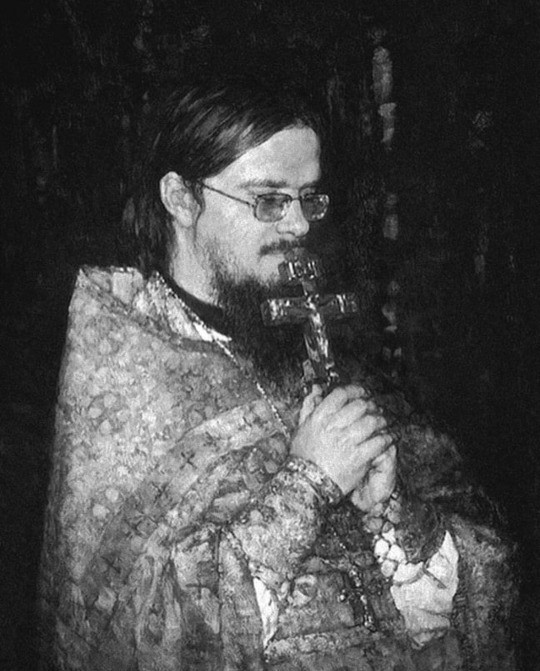
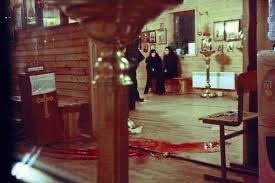
The Blood of the Martyrs is the Seed of the Church
New Hieromartyr Daniel Sysoev received the crown of martyrdom 15 years ago in Moscow, at the Church of the Holy Apostle Andrew. He was a valiant confessor and preacher, infamous amongst the Muslims, atheists, neo-pagans, and Protestants in Russia. Prior to his martyrdom, he received countless death threats, but continued on his work preaching and baptizing those outside the Church, fearing not the threat of persecution but only the righteous judgment of God.
Father Daniel was hearing a confession in the sanctuary of the church when a masked Muslim gunman burst into the building, shot at the choir director and yelled “Where is Sysoev?”
Courageously, Father Daniel exited the sanctuary and revealed himself to the gunman. He was shot several times across the chest and to the back of his head, fighting for his life until the next morning.
On the 20th of November 2009, he departed this life and entered into the heavenly kingdom. He left behind a wife and three daughters, and a great example for us Christians to be fearless in the face of death and persecution.
Through the prayers of your new hieromartyr Daniel Sysoev, Lord Jesus Christ our God, have mercy on us and save us. Amen.
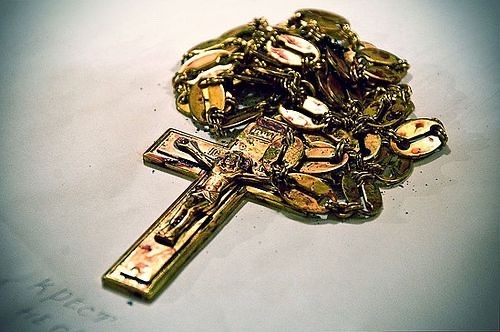
The pectoral cross of Father Daniel, washed in his blood.
#orthodox christianity#orthodoxy#eastern orthodoxy#christianity#eastern orthodox#orthodox#orthodox church#russian orthodox#martyrs#Daniel Sysoev
29 notes
·
View notes
Text

Emperor David of Trebizond (1408-1463) and some of his sons (including Basil and Manuel).
David's surrender on 15 August 1461 marks the end of the Empire of Trebizond and of the Byzantine imperial tradition.
#byzantine#roman empire#byzantine empire#Komnenian dynasty#Κομνηνός#komnenos#eastern roman empire#Trapezuntine Empire#Empire of Trebizond#David Megas Komnenos#Siege of Trebizond#Emperor and Autocrat of all the East and Perateia#Emperor of Trebizond#Holy Martyr David#st david#saints#orthodox church#christianism
13 notes
·
View notes
Text
May 11, 2023
Earlier today, Pope Francis declared that 21 Coptic Orthodox Christians, who were beheaded by Islamic militants in Libya in 2015, would be added to the Roman Martyrology. Francis made the announcement during an audience with Pope Tawadros II, the leader of the Coptic Orthodox Church of Alexandria. The “21 Coptic New Martyrs of Libya,” as they are called, were martyred on February 15, 2015. Less than a week later, they were declared saints in the Coptic Orthodox Church by Pope Tawadros. The Copts celebrate their feast on the anniversary of their death, February 15, and it appears that this will also be their feast day on the Roman calendar.
The world was shocked in February 2015, when a 5-minute video was uploaded to the internet by ISIS militants. The video showed the 21 kidnapped men in orange jumpsuits being beheaded on a beach near the Libyan city of Sirte. 20 of these martyrs were Egyptian Copts who had gone to Libya to do construction work. The last member of the group, Matthew Ayariga, was a fellow worker from Ghana. It is said that he told the executioners, “Their God is my God. I will go with them.” There has been some question over whether he was already Christian or whether the witness of his 20 coworkers led to his conversion, but nevertheless, his Christian witness and solidarity are inspiring. It was reported that as they died, they chanted hymns and prayed aloud.
The deaths of these men as Christian martyrs is undeniable. The extraordinary photos of Blessed Miguel Pro, a Catholic priest who was executed by the Mexican government in 1927 during the Cristero War — taken just moments before the he was shot by the firing squad — are perhaps the only other photographic images recording a Christian martyrdom as it happened. And yet the recognition of the 21 martyrs as Catholic saints is unprecedented for several reasons.
The primary reason, of course, is that the Coptic Orthodox Church is not in full communion with Rome. The Copts are Oriental Orthodox (as opposed to Eastern Orthodox), because they split from the other Christian churches in the year 451 at the Council of Chalcedon due to differences over the nature of Christ. They are also referred to as “Non-Chalcedonian Orthodox Churches.” This means that they recognize the first three ecumenical councils, whereas the Eastern Orthodox recognize seven, and the Catholic Church recognizes 21 ecumenical councils.
After more than 15 centuries, our hope of reunion may seem remote. After all these years, the two Churches have independently developed their own traditions, theologies, forms of worship, and prayers. Yet some things have remained the same. Both Churches have maintained apostolic succession and the sacraments: Pope Francis is the successor of St. Peter and Pope Tawadros is the successor of St. Mark. In recent decades, the relationship between the Catholic Church and the Coptic Orthodox Church has become closer. For example, in 2017, Popes Francis and Tawadros made a joint statement indicating mutual acceptance of the validity of baptism in both Churches.
Pope Francis has praised the Martyrs of Libya many times, and today he recalled our shared baptism, as well as the blood of martyrs that enriches the Church. He said, “These martyrs were baptized not only in the water and Spirit, but also in blood, a blood that is the seed of unity for all of Christ’s followers.” In the past, the pope has discussed how we must realize that we, the baptized, have much more in common than what divides us. This shared recognition of sainthood between the two Churches is a significant step towards Christian unity.
This sets a new precedent. In 1964, when the Ugandan Martyrs were canonized by Pope Paul VI, St. Charles Lwanga and the other 21 Catholics among his companions were declared saints. The 23 Anglicans who were martyred alongside them were mentioned briefly in the pope’s homily, when he said, “And we do not wish to forget, the others who, belonging to the Anglican confession, met death for the name of Christ.”
Another reason why today’s announcement is unique was that Pope Francis did this by an official act. The Roman Martyrology is the official list of saints officially recognized by the Latin Church. Many Eastern Catholic Churches have their own processes for canonizing saints according to their traditions. Historically, when groups of Eastern Catholics have come into full communion with Rome, they will bring along their saints and prayers and traditions. Many of these saints aren’t officially canonized by Rome, and they are usually only venerated in their own tradition. By inscribing the names of these martyrs in the Roman Martyrology, Pope Francis has made it clear that these martyrs are to be venerated by Roman Catholics as saints.
Finally, in declaring them saints today, Pope Francis sidestepped the typical canonization process. They are saints, without having passed through the usual stages of Servant of God, Venerable, and Blessed. This “skipping” of steps is commonly referred to as “equipollent canonization.” Essentially, when a pope declares someone a saint by an official act, that person is recognized as a saint in the Church. This is not the first time Francis has moved a case along in this way. For example, when he canonized Popes John XXIII and John Paul II in 2014, he waived the requirement of a second miracle for John XXIII so that the two popes would be canonized on the same day. In 2013, he elevated the Jesuit Peter Faber, whose status had lingered at “Blessed” since 1872.
Perhaps the most interesting case is that of St. Gregory of Narek, an Armenian monk venerated as a saint in the Armenian Catholic Church and the Armenian Apostolic Church. Unexpectedly, Pope Francis named him the 36th Doctor of the Church in 2015. Living from in the mid-10th century through the early 11th, St. Gregory lived at a time when the Armenian Church was not in communion with Rome. After several failed attempts at reunion, the Armenian Catholic Church was officially recognized as an Eastern Catholic Church in 1742. Interestingly, the Armenian Catholic eparchy of Buenos Aires (established in 1989 by Pope John Paul II) is called the Eparchy of Saint Gregory of Narek. Perhaps this is how Pope Francis became familiar with the saint.
We Christians are blessed with a wide variety of saints from all sorts of backgrounds. They help make up the beautiful tapestry of the people of God — praying for us, interceding for us, and inspiring us. This is something worth celebrating.
21 Coptic New Martyrs of Libya, Pray for Us!
Mike Lewis. Bolded emphases added.
#Catholicism#Oriental Orthodox Christianity#Christianity#saints#martyrs#Libyan Martyrs#My Pope#Pope Tawadros II#Ugandan Martyrs#Miguel Pro
123 notes
·
View notes
Text
The Forgotten Saint of the Russian Revolution
Today, the Russian Orthodox Church commemorates Tsar Nicholas Romanov II and family. It's worth noting at this time that unlike Roman Catholicism, canonization (or "glorification") in Orthodoxy is not universal. That is, just because the institution that currently backs Putin has recognized a saint, doesn't mean the rest of the Orthodox faithful must.
The Russian patriarchate would have you believe that the Romanovs were great rulers and holy people who rained prosperity down on their subjects and then, suddenly, for no reason at all, godless Communists took over and murdered the entire family because the Romanovs were such devout Christians. Historical record disproves this narrative. Nothing happens in a vacuum. The Russian people had good reason to want Nicholas gone.
By 1905, the workers and peasants of Russia were trudging up to the first full decade of Tsar Nicholas's rule and things were not going well. The Tsar's outlandish taxes were robbing the people of what little money they had, poor working conditions in the city and starvation in the rural areas led to strikes and bread riots. The Tsar ignored the pleas of the people as well as the legislation of the Duma (disbanding them entirely in 1906).
On Sunday 22nd January, 1905, Ukrainian-born Russian Orthodox priest Father Georgy Apollonovich Gapon led a group of workers and farmers in a peaceful march to the Winter Palace. The group, led by the priest bearing a cross aloft, carried a heartfelt petition to the Tsar and alternated between singing the imperial anthem "God Save the Tsar" and reciting the Lord's Prayer. Despite their clearly peaceful and cooperative intentions, the procession was met with hostility by the imperial guard. The Tsar left no clear instructions to his guards and at various times the peaceful protestors received contradictory commands. They were simultaneously told to halt, retreat, and advance towards the palace in smaller groups. Because of this disorder, it is no surprise violence broke out. The guards fired into the crowd and the cossacks rode in on horseback, cutting down many with their sabres and trampling down women and children. At the end of Bloody Sunday, as it came to be called, 132 were dead and 1,000 more were wounded. Among the injured was Father Gapon himself who, although shot in the head, managed to survive. He was secreted away by a friend into an alley where his clerical clothes were removed (police were targeting him because he was a priest) and a common factory worker disguise was donned.
Father Gapon recovered from his wounds and fled the country to London for a short time where he stayed with friends in the Socialist Revolutionary Party. During this time, he wrote a letter anathematizing Tsar Nicholas, as well as several correspondences with Vladimir Lenin. He returned to Moscow in late 1905 but was betrayed by secret police spies within the Socialist Revolutionary Party.
On April 10 1906, Pinhas Rutenberg (the very man who had saved his life on Bloody Sunday) and Yevno Fishelevich Azef invited Father Gapon to Rutenberg's house under the pretext of a secret meeting. There they hung the good priest from a coat hook and held him down until he strangled to death. In 1909, the SRP discovered that Azef was the real police spy and had framed Father Gapon for his own activities. He fled to Germany where he died of natural causes in 1918.
While the death of the Romanov family (especially the children) was unfortunate, and there is at least one holy member among them (Elizabeth Feodorovna), Father Gapon's life is far more worthy of commemoration by the Church, his death far closer to martyrdom. Instead of a life of lavish riches surrounded by servants, the Priest of God led a humble life of service to the Church and the poor, imitating Our Lord's life of service. His betrayal and murder were not the natural consequences of a hard heart, inept rule, and negligent care; but rather a great evil perpetrated by those who wished to stop his charitable work. It is for this reason that on this day, I choose to remember the true saint, Father Georgy Gapon who gave his life for the people of Russia.

Picture: Portrait of Father Georgy Gapon

Picture: Father Gapon leads the peaceful procession outside of Narva Gate

Polish artist Wojciech Horacy Kossak's rendering of the events of Bloody Sunday painted in May of 1905. Father Gapon is featured in front, standing stalwart, holding the cross aloft as innocents are murdered around him.
#orthodoxy#orthodox church#orthodox christianity#queer christian#trans christian#faithfullylgbtq#orthodoxleftist#inclusiveorthodoxy#thisglassdarkly#gay christian#lgbt christian#progressive christian#christian socialism#russian orthodox#orthodox christian#socialism#martyrs
9 notes
·
View notes
Text

+++🙏🏻God Bless🕊️+++
Hieromartyr Saturninus of Toulouse, Bishop
MEMORIAL DAY DECEMBER 12
💫International Orthodox Art Corporation Andcross May the blessing of the Lord be upon you!
#orthodox christmas#orthodox church#orthodox icon#orthodox christian#russian orthodox#orthodoxia#iconofaday#orthodox#greek orthodox#jesus#martyr#orthodoxy#orthodox christianity#eastern orthodoxy#eastern orthodox christian
4 notes
·
View notes
Text

Painter Daniel Codrescu working on the project of the Năsăud Martyrs for the mosaic of the National Cathedral, on January 14, 2023. Photo: Instagram / Daniel Codrescu
11 notes
·
View notes
Text

#martyrs#goth aesthetic#dark aesthetic#orthodox christianity#orthodox saints#kingdom of heaven#blessed#holy spirit#body of christ#saints
4 notes
·
View notes
Text
We used to hate and destroy one another and refused to associate with people of another race or country. Now, because of Christ, we live together with such people and pray for our enemies. + St. Justin Martyr
26 notes
·
View notes
Text
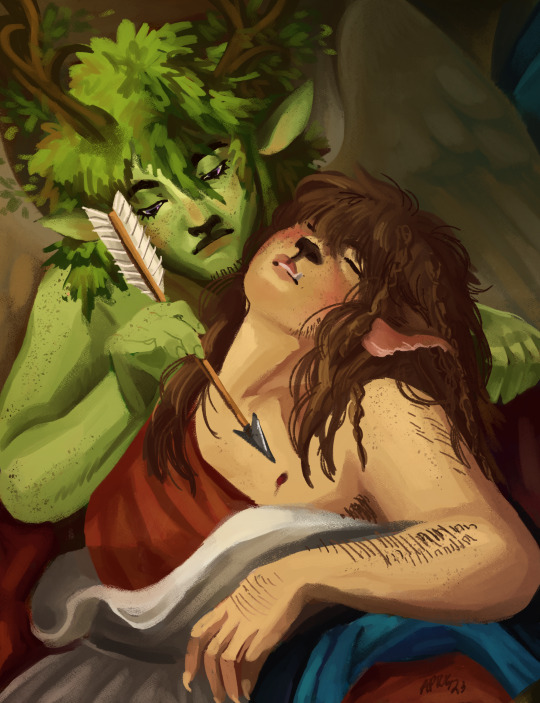

master studies
#pokemon patronage au#forester may#ria tiraboschy#lazlo morre#rov art#master study#icon art#1st eros and psyche from the circle of jean baptiste greuze#2nd based on traditional orthodox icons particularly joan of arc and the angels#im taking master study based commies if anyone is interested btw.#happy holidays let me draw your bingus as a classical figure or perhaps a martyr#lazria
12 notes
·
View notes
Text

Saint George the Great Martyr
Icon by me
The Holy Great Martyr George the Victory-Bearer, was a native of Cappadocia (a district in Asia Minor), and he grew up in a deeply believing Christian family. His father was martyred for Christ when George was still a child. His mother, owning lands in Palestine, moved there with her son and raised him in strict piety.
When he became a man, Saint George entered into the service of the Roman army. He was handsome, brave and valiant in battle, and he came to the notice of the emperor Diocletian (284-305) and joined the imperial guard with the rank of comites, or military commander.
The pagan emperor, who did much for the restoration of Roman might, was clearly concerned with the danger presented to pagan civilization by the triumph of the Crucified Savior, and intensified his persecution against the Christians in the final years of his reign. Following the advice of the Senate at Nicomedia, Diocletian gave all his governors full freedom in their court proceedings against Christians, and he promised them his full support.
Saint George, when he heard the decision of the emperor, distributed all his wealth to the poor, freed his servants, and then appeared in the Senate. The brave soldier of Christ spoke out openly against the emperor’s designs. He confessed himself a Christian, and appealed to all to acknowledge Christ: “I am a servant of Christ, my God, and trusting in Him, I have come among you voluntarily, to bear witness concerning the Truth.”
“What is Truth?” one of the dignitaries asked, echoing the question of Pontius Pilate. The saint replied, “Christ Himself, Whom you persecuted, is Truth.”
Stunned by the bold speech of the valiant warrior, the emperor, who had loved and promoted George, attempted to persuade him not to throw away his youth and glory and honors, but rather to offer sacrifice to the gods as was the Roman custom. The confessor replied, “Nothing in this inconstant life can weaken my resolve to serve God.”
Then by order of the enraged emperor the armed guards began to push Saint George out of the assembly hall with their spears, and they then led him off to prison. But the deadly steel became soft and it bent, just as the spears touched the saint’s body, and it caused him no harm. In prison they put the martyr’s feet in stocks and placed a heavy stone on his chest.
The next day at the interrogation, powerless but firm of spirit, Saint George again answered the emperor, “You will grow tired of tormenting me sooner than I will tire of being tormented by you.” Then Diocletian gave orders to subject Saint George to some very intense tortures. They tied the Great Martyr to a wheel, beneath which were boards pierced with sharp pieces of iron. As the wheel turned, the sharp edges slashed the saint’s naked body.
At first the sufferer loudly cried out to the Lord, but soon he quieted down, and did not utter even a single groan. Diocletian decided that the tortured one was already dead, and he gave orders to remove the battered body from the wheel, and then went to a pagan temple to offer thanks.
At this very moment it got dark, thunder boomed, and a voice was heard: “Fear not, George, for I am with you.” Then a wondrous light shone, and at the wheel an angel of the Lord appeared in the form of a radiant youth. He placed his hand upon the martyr, saying to him, “Rejoice!” Saint George stood up healed.
When the soldiers led him to the pagan temple where the emperor was, the emperor could not believe his own eyes and he thought that he saw before him some other man or even a ghost. In confusion and in terror the pagans looked Saint George over carefully, and they became convinced that a miracle had occurred. Many then came to believe in the Life-Creating God of the Christians.
Two illustrious officials, Saints Anatolius and Protoleon, who were secretly Christians, openly confessed Christ. Immediately, without a trial, they were beheaded with the sword by order of the emperor. Also present in the pagan temple was Empress Alexandra, the wife of Diocletian, and she also knew the truth. She was on the point of glorifying Christ, but one of the servants of the emperor took her and led her off to the palace.
The emperor became even more furious. He had not lost all hope of influencing Saint George, so he gave him over to new and fiercesome torments. After throwing him into a deep pit, they covered it over with lime. Three days later they dug him out, but found him cheerful and unharmed. They shod the saint in iron sandals with red-hot nails, and then drove him back to the prison with whips. In the morning, they led him back to the interrogation, cheerful and with healed feet, and the emperor asked if he liked his shoes. The saint said that the sandals had been just his size. Then they beat him with ox thongs until pieces of his flesh came off and his blood soaked the ground, but the brave sufferer, strengthened by the power of God, remained unyielding.
The emperor concluded that the saint was being helped by magic, so he summoned the sorcerer Athanasius to deprive the saint of his miraculous powers, or else poison him. The sorcerer gave Saint George two goblets containing drugs. One of them would have quieted him, and the other would kill him. The drugs had no effect, and the saint continued to denounce the pagan superstitions and glorify God as before.
When the emperor asked what sort of power was helping him, Saint George said, “Do not imagine that it is any human learning which keeps me from being harmed by these torments. I am saved only by calling upon Christ and His Power. Whoever believes in Him has no regard for tortures and is able to do the things that Christ did” (John 14:12). Diocletian asked what sort of things Christ had done. The Martyr replied, “He gave sight to the blind, cleansed the lepers, healed the lame, gave hearing to the deaf, cast out demons, and raised the dead.”
Knowing that they had never been able to resurrect the dead through sorcery, nor by any of the gods known to him, and wanting to test the saint, the emperor commanded him to raise up a dead person before his eyes. The saint retorted, “You wish to tempt me, but my God will work this sign for the salvation of the people who shall see the power of Christ.”
When they led Saint George down to the graveyard, he cried out, “O Lord! Show to those here present, that You are the only God in all the world. Let them know You as the Almighty Lord.” Then the earth quaked, a grave opened, the dead one emerged from it alive. Having seen with their own eyes the Power of Christ, the people wept and glorified the true God.
The sorcerer Athanasius, falling down at the feet of Saint George, confessed Christ as the All-Powerful God and asked forgiveness for his sins, committed in ignorance. The obdurate emperor in his impiety thought otherwise. In a rage, he commanded both Athanasius and the man raised from the dead to be beheaded, and he had Saint George again locked up in prison.
The people, weighed down with their infirmities, began to visit the prison and they there received healing and help from the saint. A certain farmer named Glycerius, whose ox had collapsed, also visited him. The saint consoled him and assured him that God would restore his ox to life. When he saw the ox alive, the farmer began to glorify the God of the Christians throughout all the city. By order of the emperor, Saint Glycerius was arrested and beheaded.
The exploits and the miracles of the Great Martyr George had increased the number of the Christians, therefore Diocletian made a final attempt to compel the saint to offer sacrifice to the idols. They set up a court at the pagan temple of Apollo. On the final night the holy martyr prayed fervently, and as he slept, he saw the Lord, Who raised him up with His hand, and embraced him. The Savior placed a crown on Saint George’s head and said, “Fear not, but have courage, and you will soon come to Me and receive what has been prepared for you.”
In the morning, the emperor offered to make Saint George his co-administrator, second only to himself. The holy martyr with a feigned willingness answered, “Caesar, you should have shown me this mercy from the very beginning, instead of torturing me. Let us go now to the temple and see the gods you worship.”
Diocletian believed that the martyr was accepting his offer, and he followed him to the pagan temple with his retinue and all the people. Everyone was certain that Saint George would offer sacrifice to the gods. The saint went up to the idol, made the Sign of the Cross and addressed it as if it were alive: “Are you the one who wants to receive from me sacrifice befitting God?”
The demon inhabiting the idol cried out, “I am not a god and none of those like me is a god, either. The only God is He Whom you preach. We are fallen angels, and we deceive people because we are jealous.”
Saint George cried out, “How dare you remain here, when I, the servant of the true God, have entered?” Then noises and wailing were heard from the idols, and they fell to the ground and were shattered.
There was general confusion. In a frenzy, pagan priests and many of the crowd seized the holy martyr, tied him up, and began to beat him. They also called for his immediate execution.
The holy empress Alexandra tried to reach him. Pushing her way through the crowd, she cried out, “O God of George, help me, for You Alone are All-Powerful.” At the feet of the Great Martyr the holy empress confessed Christ, Who had humiliated the idols and those who worshipped them.
Diocletian immediately pronounced the death sentence on the Great Martyr George and the holy Empress Alexandra, who followed Saint George to execution without resisting. Along the way she felt faint and slumped against a wall. There she surrendered her soul to God.
Saint George gave thanks to God and prayed that he would also end his life in a worthy manner. At the place of execution the saint prayed that the Lord would forgive the torturers who acted in ignorance, and that He would lead them to the knowledge of Truth. Calmly and bravely, the holy Great Martyr George bent his neck beneath the sword, receiving the crown of martyrdom on April 23, 303.
The pagan era was coming to an end, and Christianity was about to triumph. Within ten years, Saint Constantine (May 21) would issue the Edict of Milan, granting religious freedom to Christians.
Of the many miracles worked by the holy Great Martyr George, the most famous are depicted in iconography. In the saint’s native city of Beirut were many idol-worshippers. Outside the city, near Mount Lebanon, was a large lake, inhabited by an enormous dragon-like serpent. Coming out of the lake, it devoured people, and there was nothing anyone could do, since the breath from its nostrils poisoned the very air.
On the advice of the demons inhabiting the idols, the local ruler came to a decision. Each day the people would draw lots to feed their own children to the serpent, and he promised to sacrifice his only daughter when his turn came. That time did come, and the ruler dressed her in her finest attire, then sent her off to the lake. The girl wept bitterly, awaiting her death. Unexpectedly for her, Saint George rode up on his horse with spear in hand. The girl implored him not to leave her, lest she perish.
The saint signed himself with the Sign of the Cross. He rushed at the serpent saying, “In the Name of the Father and of the Son and of the Holy Spirit.” Saint George pierced the throat of the serpent with his spear and trampled it with his horse. Then he told the girl to bind the serpent with her sash, and lead it into the city like a dog on a leash.
The people fled in terror, but the saint halted them with the words: “Don’t be afraid, but trust in the Lord Jesus Christ and believe in Him, since it is He Who sent me to save you.” Then the saint killed the serpent with a sword, and the people burned it outside the city. Twenty-five thousand men, not counting women and children, were then baptized. Later, a church was built and dedicated to the Most Holy Theotokos and the Great Martyr George.
Saint George went on to become a talented officer and to amaze the world by his military exploits. He died before he was thirty years old. He is known as Victory Bearer, not only for his military achievements, but for successfully enduring martyrdom. As we know, the martyrs are commemorated in the dismissal at the end of Church services as “the holy, right victorious martyr....”
Saint George was the patron saint and protector of several of the great builders of the Russian state. Saint Vladimir’s son, Yaroslav the Wise (in holy Baptism George), advanced the veneration of the saint in the Russian Church. He built the city of Yuriev [i.e., “of Yurii.” “Yurii” is the diminutive of “George”, as “Ivan” is of “John”], he also founded the Yuriev monastery at Novgorod, and he built a church of Saint George the Victory Bearer at Kiev.
The day of the consecration of Saint George’s Church in Kiev, November 26, 1051 by Saint Hilarion, Metropolitan of Kiev and All Rus, has entered into the liturgical treasury of the Church as a special church feastday. Yuriev Day is beloved by the Russian people as an “autumn Feast of Saint George.”
The name of Saint George was also borne by the founder of Moscow, Yurii Dolgoruky (+ 1157), who was the builder of many churches dedicated to Saint George, and the builder of the city of Yuriev-Polsk. In the year 1238 the heroic fight of the Russian nation against the Mongol Horde was led by the Great Prince Yurii (George) Vsevolodovich of Vladimir (February 4), who fell at the Battle at the Sita River. His memory, like that of Igor the Brave, and defender of his land, was celebrated in Russian spiritual poems and ballads.
The first Great Prince of Moscow, when Moscow had become the center of the Russian Land, was Yurii Danilovich (+ 1325), the son of Saint Daniel of Moscow, and grandson of Saint Alexander Nevsky. From that time Saint George the Victory Bearer, depicted as a horseman slaying the serpent, appeared on Moscow’s coat of arms, and became an emblem of the Russian state. This has strengthened Russia’s connections with Christian nations, and especially with Iberia (Georgia, the Land of Saint George).
(www.oca.org/saints/lives/2015/…)
Saint George the Victory Bearer and Great Martyr, pray for us!
#byzantine#Byzantine icon#christian#Greek#Greek orthodox#icon#iconography#martyr#orthodox#Orthodox Church#Russian#Russian orthodox#saint#Saint George#saints#christian iconography#Eastern Orthodox#Russian icon#Greek icon#Eastern Orthodox Church#orthodox icon#Saint George the martyr#great saint#orthodox martyr#Wonderworking saint#trophy bearer#English saint#saint icon#orthodoxy#christianity
17 notes
·
View notes
Text

Tsar Nicholas II of Russia.
#die romanows#zarenreich#tsardom of russia#house of romanov#tsar#tsar nicholas ii#passion bearer#martyr#saints#orthodox church#christianism#the last tsar#bearded men
7 notes
·
View notes
Text

“In 311 A.D. you could not be a member of the fighting Roman army and be a Christian. By 416 A.D. you couldn’t be a member of the fighting Roman army unless you were a Christian. In 105 years it completely reversed itself.
Killing people in the first three centuries (or at least until 265 A.D.) was not just a sin, it was an excommunicable offense. It doesn’t mean that Christians didn’t kill people. Sure there were Christians who killed people, just as some Christians committed adultery. But it means that the Church said, without any doubt, that killing was evil. The Church did not justify killing as a way of following Christ.”
~Father Emmanuel Charles McCarthy
(Via Gebre Menfes Kidus)
#Orthodox Christian#killing#serving in the armed forces#following Christ#conscientious objector#saints#St. Marcellus the Centurion#Gebre Menfes Kidus#martyr
33 notes
·
View notes
Text

2 notes
·
View notes
Text

yk these pages r getting funded by israel if they unabashedly post bullshit like this. the zionists hated palestinians so much, they started saying hitler wasnt that bad like wtf
#same energy as anima writers hating women so much that their male characters come across as having homoerotic relationships#this is just crazy atp like can they hear themselves talk#zionism is nazism btw#and zionists are antisemitic asf like i just saw a vid of a pro israel woman going up to pro palestine orthodox jews and#telling them that hitler shouldve gassed them and istg my jaw dropped???? that was so dsgusting like#how do these people rationalize and justify these actions to themselves#those jews remained so calm and collected like theyre better than me bec if i was them id start throwing punches#free palestine#palestine#gaza#long live palestine#glory to the martyrs#from the river to the sea palestine will be free#long live the resistance#death to israel
8 notes
·
View notes
Text
Remembering St. Jude Thaddaeus, the Apostle (19th August)
St. Jude, also known as Thaddeus, was a dedicated apostle of Jesus Christ, spreading His teachings across distant lands. Learn about his life, contributions, and enduring legacy in this comprehensive blog.
In the name of God the Father, Christ Jesus His Son and the Holy Spirit, One True God. Amen. IntroductionIdentityNew TestamentJude – Brother of Jesus?Tradition & LegendLetter of St. JudeMartyrdom & RemainsIconographic RepresentationPatronage & Pilgrimage CentresConclusion Introduction On August 19th, we remember one of the 12 Apostles of Jesus and considered as the founding father and first…
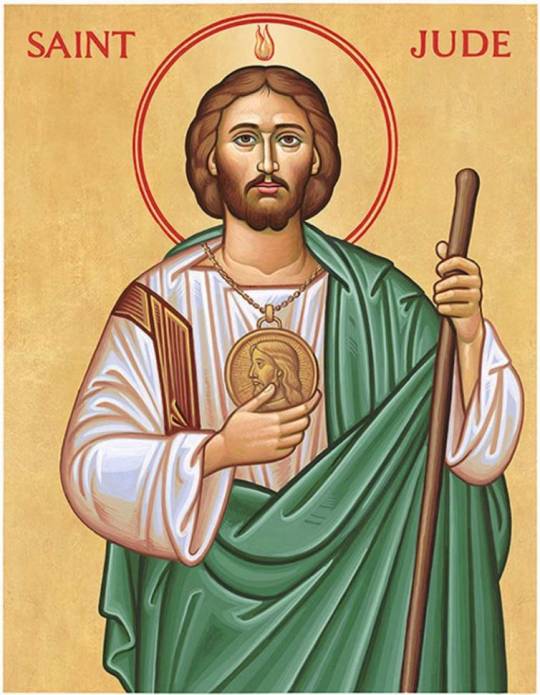
View On WordPress
#Apostle of Jesus#Apostle Thaddeus#Armenian Apostolic Church#Christian Martyr#Christian Tradition#Early Christian Movement#Epistle of Jude#featured#Gospel of Jude#image of Edessa#Jude&039;s Patronage#Legends of St. Jude#Martyrdom#Orthodox faith#Patron of Impossible Causes#Patron Saint#Pentecost#Saint Bartholomew#St. Jude#St. Jude&039;s relics
3 notes
·
View notes
Text

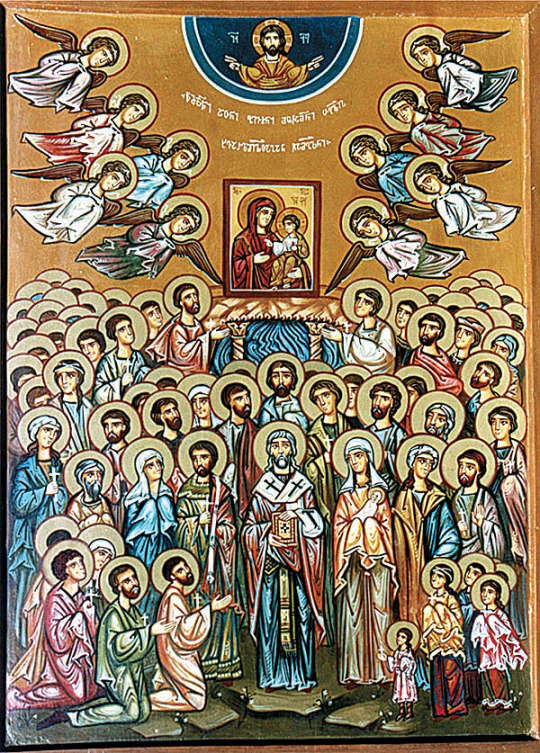
Who are the martyrs?
Derived from the Greek word meaning "witness," a martyr is someone who suffers persecution and death for their faith in Christ. Saint Gregory the Theologian, the 4th Century Patriarch of Constantinople, once said that "it is mere rashness to seek death, but it is cowardly to refuse it" in witnessing to our faith in Christ. Over the past two millennia martyrs have been a symbol of strength for the faithful, a sign that God is more powerful than death. All of the Apostles, who experienced the Risen Jesus, except for St. John the Evangelist, were put to death for their faith in Christ. That so many Christians who knew Jesus were willing to die for their claim that "Jesus is Lord" (1 Corinthians 12:3) gives a powerful witness to us about who Jesus is. As St. Justin the Martyr wrote in the 2nd century just before his own execution in Rome for the faith circa 155AD: "for it is plain that, though beheaded, and crucified, and thrown to wild beasts, and chains, and fire, and all other kinds of torture, we do not give up our confession of faith; but, the more these things happen, the more others, in even larger numbers, become faithful." This persecution of Christianity has continued through the centuries. To this day, Orthodox Christians continue to be persecuted under Communism, various dictatorships, and other religions. In fact, more Orthodox Christians died for their faith in the 20th century under Communism in the former Soviet bloc countries than in all the persecutions carried out by the Roman Empire during the first 300 years of Christian history.
St. Stephen (In Greek, stephanos means 'crown') was the first person in history to be executed for being a Christian. His story is told in the New Testament by Luke the Evangelist in the Acts of the Apostles (6:1-7:60). A "man full of the Holy Spirit," he was one of the seven deacons chosen by the Apostles to minister to the Greek-speaking Christians of the first community in Jerusalem. Arrested for his public preaching of Jesus Christ, he was -- like his Master before him -- brought before the Sanhedrin. For his witness before the Sanhedrin to Jesus as the crucified and risen Messiah, he was condemned to death by stoning. Taken outside the city walls, he was brutally stoned to death by an angry mob. Stephen was the first of a long line of many, many men and women who have paid the full price in blood for their faith in Jesus Christ.
[Source of text: The Divine Liturgy of our Father among the Saints John Chrysostom (with Commentary and Notes)]
18 notes
·
View notes